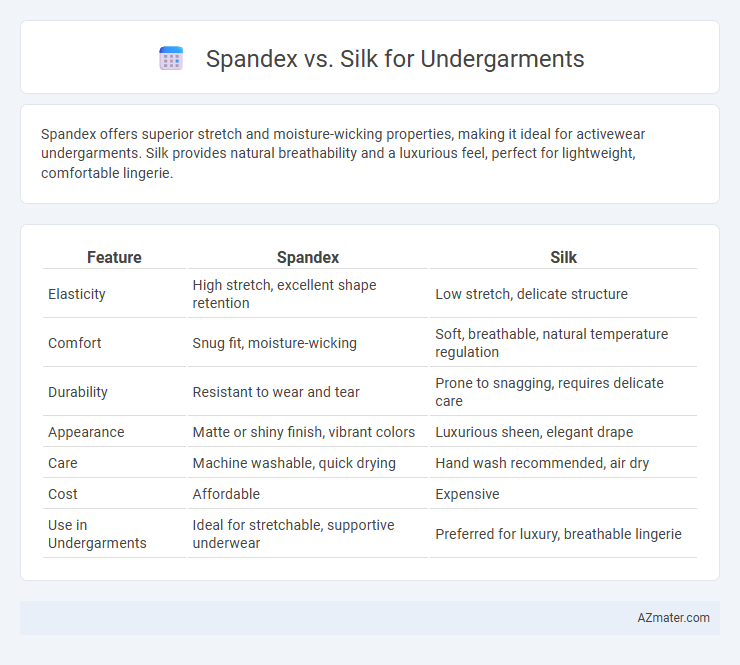Spandex offers superior stretch and moisture-wicking properties, making it ideal for activewear undergarments. Silk provides natural breathability and a luxurious feel, perfect for lightweight, comfortable lingerie.
Table of Comparison
| Feature | Spandex | Silk |
|---|---|---|
| Elasticity | High stretch, excellent shape retention | Low stretch, delicate structure |
| Comfort | Snug fit, moisture-wicking | Soft, breathable, natural temperature regulation |
| Durability | Resistant to wear and tear | Prone to snagging, requires delicate care |
| Appearance | Matte or shiny finish, vibrant colors | Luxurious sheen, elegant drape |
| Care | Machine washable, quick drying | Hand wash recommended, air dry |
| Cost | Affordable | Expensive |
| Use in Undergarments | Ideal for stretchable, supportive underwear | Preferred for luxury, breathable lingerie |
Overview: Spandex vs Silk in Undergarments
Spandex offers exceptional stretch, durability, and moisture-wicking properties, making it ideal for form-fitting underwear and activewear. Silk, valued for its natural softness, breathability, and hypoallergenic qualities, provides luxurious comfort and temperature regulation in intimate apparel. Choosing between spandex and silk depends on the desired balance of flexibility, support, and elegance in undergarments.
Fabric Composition and Structure
Spandex, a synthetic fiber composed primarily of polyurethane, offers high elasticity and stretch, making it ideal for form-fitting undergarments that provide support and freedom of movement. Silk, a natural protein fiber produced by silkworms, features a smooth, breathable, and hypoallergenic structure that enhances comfort and moisture-wicking properties. While spandex excels in durability and shape retention due to its elastic polymer chains, silk's luxurious texture and temperature-regulating fibers make it a preferred choice for softness and natural insulation in intimate apparel.
Comfort and Feel on Skin
Spandex offers exceptional stretch and a snug fit, making it ideal for active wear and undergarments that require flexibility, while its synthetic fibers wick moisture effectively to enhance comfort during movement. Silk provides a luxurious, soft touch that feels gentle and smooth against the skin, promoting breathability and temperature regulation, perfect for sensitive skin and all-day wear. Comparing the two, spandex excels in elasticity and moisture management, whereas silk stands out for its natural softness and hypoallergenic properties.
Breathability and Moisture Management
Spandex offers excellent moisture-wicking properties that keep the skin dry by efficiently drawing sweat away from the body, enhancing comfort during physical activity. Silk provides superior natural breathability and temperature regulation due to its fiber structure, allowing air circulation and reducing heat buildup. For undergarments, spandex suits active wear with high moisture management needs, while silk excels in breathable comfort for everyday use.
Stretchability and Fit
Spandex offers superior stretchability compared to silk, ensuring a snug, flexible fit that adapts to body movements without losing shape. Silk provides a smooth, natural drape but lacks the elasticity required for a close-fitting undergarment that maintains support throughout wear. Combining spandex's high elasticity with silk's softness can optimize both comfort and fit in undergarments.
Durability and Longevity
Spandex undergarments are highly durable due to their excellent elasticity and resistance to wear and tear, making them ideal for frequent use and washing. Silk, while luxurious and breathable, is more delicate and prone to damage from abrasion, chemicals, and prolonged exposure to moisture, which can shorten its lifespan. For consumers prioritizing long-lasting undergarments, spandex offers superior longevity compared to silk, especially in active or everyday wear scenarios.
Allergenicity and Skin Sensitivity
Spandex is a synthetic fiber that may cause allergic reactions or skin irritation in sensitive individuals due to chemicals used in its production, making it less ideal for people with sensitive skin or allergies. Silk, a natural protein fiber, is hypoallergenic and breathable, reducing the risk of irritation and making it suitable for sensitive skin and those prone to allergies. Choosing silk undergarments enhances comfort and skin compatibility while spandex offers more stretch but with potential allergenicity concerns.
Care and Maintenance Requirements
Spandex undergarments require gentle washing with cold water and mild detergent to maintain elasticity and prevent fabric breakdown, avoiding bleach and high heat drying. Silk undergarments need delicate hand washing or dry cleaning to preserve their natural fibers and sheen, and should be air dried away from direct sunlight to prevent discoloration. Both fabrics demand careful handling, but silk's sensitivity to water and detergents makes its care more intricate compared to the stretch-resistant and durable spandex.
Eco-Friendliness and Sustainability
Spandex is a synthetic fiber derived from petrochemicals, making it less eco-friendly due to non-renewable resource use and limited biodegradability. Silk, a natural protein fiber produced by silkworms, offers greater sustainability through its biodegradability and renewable production, though traditional sericulture raises ethical and environmental concerns. Choosing eco-friendly undergarments involves balancing silk's natural advantages with spandex's durability and considering innovations in sustainable silk production or recycled spandex materials.
Cost Comparison and Value
Spandex undergarments typically offer a lower cost per unit compared to silk, making them a more budget-friendly option for everyday wear. Silk undergarments, while more expensive upfront, provide superior breathability and natural temperature regulation, delivering enhanced comfort and longevity that justify the higher price point. Evaluating the cost-to-value ratio depends on whether durability or luxury feel is prioritized, with spandex excelling in affordability and flexibility, and silk excelling in premium quality and natural fiber benefits.

Infographic: Spandex vs Silk for Undergarment
 azmater.com
azmater.com